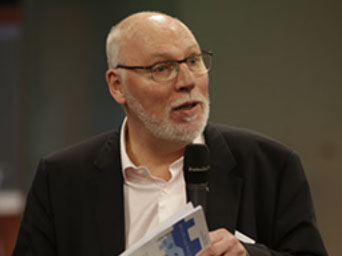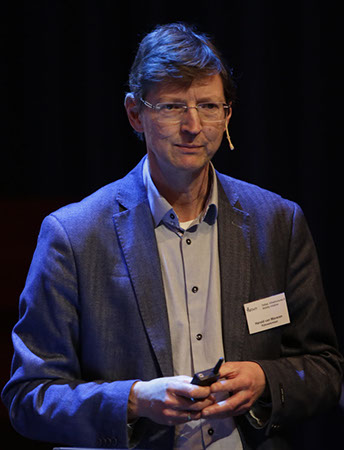Six highlights on deltas & ports
Go to:

How can a sustainable port of the future be developed while dealing with the ‘growth paradigm’? This involves facilitating economic development while taking climatic and environ-mental sustainability into account. In real life this isn’t easy. But the serious game ‘Port of the future’ offers a realistic means for testing out hypothetical situations. This game was launched at the conference ‘Deltas and Ports of the Future’ on January 28 in Delft with 35 enthusiastic participants.
In principle agreements
The game was played during the congress in five teams: the teams represented investors, city management and environmental groups. It resulted in a workshop with proposals and discussions to reach consensus. In principle agreements were made and the players found out that in some cases, there is no optimal solution to a problem: just like in real life.
People’s wellbeing
There were three rounds of implementing measures like dredging, artificial mangroves and inland locks. The group scored well on the people, planet and profit indicators. Although the environ-mental groups were well-represented, the score for planet was relatively low, showing that just like in real life, measures that increase profit and people's wellbeing are often given the highest priority.
The participants experienced an increased aware-ness of the interests of different stakeholders and an increased situational understanding. Learning and negotiating can be seriously fun.
AUTHOR: MAAIKE MAARSE, ADVISOR/RESEARCHER CLIMATE ADAPTION AND ECOLOGY AT DELTARES
Combatting uncertainty
in decisions
Delta Challenges
How to make decisions when everything is uncertain? According to Julie Rozenberg, economist of the World Bank, this is possible.
The World Bank modelled between the boundaries of twelve parameters on poverty. They found that good governance will have a bigger impact on the number of poor people by 2030 than climate change.
Difference
Jan Kwakkel, an assistant professor at TU Delft, has modelled deep uncertainty in his research. He points out that you should try to find the differences that make a difference, while stressing that the inability to validate a model is never an excuse not to make a decision.
Marjolijn Haasnoot, an environmental scientist of Deltares, has made adaptation pathway maps. How to make sure my decision is adaptive to the future? Time your pathway change right and use good signposts.
Local data
Combatting uncertainty in coastal erosion and subsidence processes is possible by combining data gathered by local stakeholders, remote sensing and modelling. For example, in Myanmar, PhD students asked local inhabitants at the coastline if they remembered how the coastline changed throughout time. These data were used to validate models.
AUTHOR: MARGOT WIGGERS, POSTDOC SUSTAINABLE DEVELOPMENT & INTERNATIONAL DEVELOPMENT AT DELTARES

Ecosystem services are often neglected, partly because they have no policy of embedding - no 'status'. The economic value of ecosystem services is often underestimated. There is no single ministry for ecosystems in The Netherlands. Ecosystems services, however, can be a tool for the develop-ment and improvement of the quality of an area. They can be useful in reconstructing the landscape. An example of an ecosystem service is a park that not only provides a space for recreation and leisure, but also has an ecological function.
Coherent
Stakeholders, experts and politicians need to come together to form a coherent policy. This involves the water boards, regional government and national government, municipalities and the relevant ministries. They must agree on a coherent, integrated policy. The role of engineers is to inform policy makers so that ecosystem services are maintained and enhanced.
Transferrable experience
Building with Nature

The application of Building with Nature – using natural materials in infrastructure - should be transferred through ideas instead of solutions. Building with Nature is a departure from conventional hydraulic engineering, and these developments have an impact on what is taught at technical universities and how research is put into practice.
Local demands
The question is whether Building with Nature can offer transferrable experience to other contexts. Jaap van Thiel de Vries, Program Manager at Boskalis, refers to different conditions along the coast of Java in Indonesia. These examples illustrate that the success of Building with Nature’s solutions depends on its ability to suit a specific environment and meet local demands and needs.
Public Consultation
The next important step is to spread this way of thinking, rather than just copy-paste the solutions. Actors from various positions including NGOs, the government, academia and private companies all argue that Building with Nature should be founded on a multi-disciplinary approach as well as collaboration and communication with the public.
AUTHOR: WENCHI YANG, STUDENT ARCHITECTURE, DEPT. OF URBANISM
Not just an economic
and water issue
IJsselmeer area

An integrated approach is required to adequately solve the problems of the IJsselmeer. This includes the transition between land and water in the IJsselmeer region. A more gradual transition is required to maintain water quality, which in turn, can create new landscapes. As such, there
is a need to define the shared values of the stakeholders in the IJsselmeer region.
Emotional investment
What does it mean when these abstract values take physical forms in the real space of the region? We have learnt that an integrated approach is needed to determine where it is best to divide, to develop and so on. It is important to consider more than just the strictly economic and water security issues and also to consider the emotional investment in the landscape.
Inclusive
What instruments can realise a method which consider all aspects? The methods need to be integrated and inclusive and values need to be realised in concrete form. Decisions needs to be made in an inclusive manner.
Powerful agglomeration
for big measures
The Adaptive Delta Metropolis

How to make decisions when everything is uncertain? According to Julie Rozenberg, economist of the World Bank, this is possible. The World Bank modelled between the boundaries of twelve parameters on poverty. They found that good governance will have a bigger impact on the number of poor people by 2030 than climate change.
Large water infrastructure is out of fashion. The engineering works the Dutch built last century were constructed after floods. At that time, people were aware of the need for such measures.
For the next century, however, we are talking about preventive measures.
Contempt
The future holds many uncertainties: from climate change to demographic developments. What's more, many people are contemptuous towards engineers. Many people have a fear of the impact grand infrastructure will have on their lives. Set against the climate change, however, the focus
is the need for more large-scale projects. Flood-resistant infrastructure will be needed to combat climate change.
Agglomeration
Adaptive planning is based on what you do know, complemented by measures that you won’t regret. Climate change affects urban agglomerations. An agglomeration like Rotterdam, which will also face problems related to climate change, should be given more responsibility to decide such measures. In Houston, for example, new measures and infrastructure are necessary after recent floods, the authorities have power to take decisions to determine their future. The city's planning needs to
re-consider its relation to water.
HAROLD VAN WAVEREN
FRITS PALMBOOM
MARCEL STIVE
BIANCA DE VLIEGER
SOPHIE VERGOUWEN
Playing with climate
and sustainability
Gaming for the Port of the Future
Embedding of
ecosystem services
The New Delta

BERT ENSERINK





